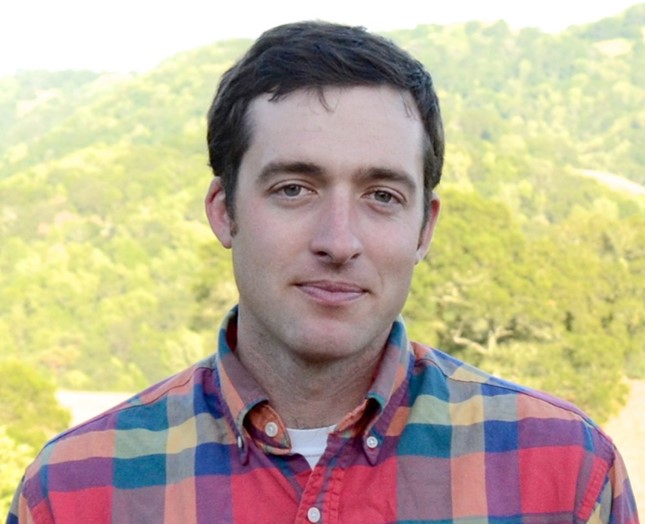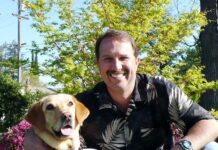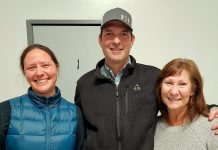
Growing up in Austin, Texas, Houston Wilson thought all of California looked like Los Angeles. After leaving Texas to pursue undergraduate studies at UC Berkeley, he quickly took a much broader view of the state and the world.
“I thought college would be a good opportunity to see a different part of the country,” said Wilson. “The University of California is a well-known public institution, and I was really interested in going to California.”
Now a UCCE Orchard/Vineyard IPM Specialist in the Dept. of Entomology, UC Riverside, and based at the UC Kearney Agricultural Research and Extension Center in Parlier, Wilson has become an authority on integrated pest management in nut crops in a part of California that looks nothing like Los Angeles (or Berkeley for that matter!).
Aside from hunting and clearing brush on ranches in his high school days, Wilson’s agriculture experience was limited to his academic pursuits studying land use policy and rural development. His major in economic policy and development had him observing the world with a global lens and focusing on issues in Latin America, Asia and Africa, which led him to look at rural development in particular. This sparked an interest in production agriculture.
“At the time, I was looking at a lot of these policy and market dimensions, how trade, economic, and land-use policies worked to promote rural and agricultural development, and I ended up getting a lot more interested in the production side of agriculture,” said Wilson.
Shortly thereafter, Wilson teamed up with Prof. Miguel Altieri and Dr. Kent Daane at UC Berkeley to work on biological control of vineyard pests. It was through this early experience with applied research and extension that Wilson discovered his love for agricultural entomology and cooperative extension, and ultimately decided to pursue a Ph.D. in agricultural entomology.
“Prior to that, I didn’t know anything about opportunities for [working in extension],” said Wilson. “When I finally came upon it, I realized immediately that it was the right blend of what I was looking for in a career. I’m able to do science in an applied atmosphere and collaborate directly with commercial growers to solve real-world problems. It’s a nice mix of being in the field, being in the lab, interacting with growers and other scientists, plus our findings have implications for both production and policy decisions. It was hitting all the marks. On top of that, it’s just really fun to be out there doing it!”
He is now in his 13th year of agricultural research and extension, his 3rd year at the Kearney Ag. Center, and just this summer was chosen to lead the newly created UC Organic Agriculture Institute. In that time, Wilson has noted a strong push towards precision agriculture and the rapid development of technology that bolsters it, such as irrigation sensors, automated insect traps and data management software that help growers record and closely track production data across large areas, and then use that information to make more informed management decisions. He has also noted increased regulations in agriculture, which will continue to put pressure on growers to find innovative ways to address things like water and pesticide use in production.
There’s also the constant threat of invasive insects. While California has always had its share of invasive pests, the ever-increasing rate of trade and movement of goods into the state continually poses the threat of introducing new pests into the region. Since his time as an undergraduate student, Wilson has seen programs developed in response to invasions by the vine mealybug, light brown apple moth, European grapevine berry moth, bagrada bug, spotted wing drosophila, Asian citrus psyllid and brown marmorated stink bug – to name a few – and he says spotted lanternfly appears to be on the horizon.
Understanding how to develop, coordinate, and implement an area-wide integrated pest management (IPM) program is one of the biggest challenges that agricultural entomologists face today. There are a number of insects that IPM experts deal with orchards, but arguably one of the most important is navel orangeworm (NOW).
“Management of NOW on a block-by-block basis can sometimes seem futile,” said Wilson. “If a grower is doing all the right things, but a lot of their neighbors are not, then they may ultimately have to deal with a lot of moths migrating into their clean blocks and causing a lot of problems.”
This is an issue seen in many cropping systems with high-ly mobile pests with a wide host range, which underscores the need for management on a regional basis.
“Area-wide IPM is a project that’s ultimately going to require some type of cooperative effort that involves growers, processors, extension, and researchers all working in tandem,” said Wilson.
Key to this process is figuring out how to best reconcile what is known about insect ecology and pest management with the economic and agronomic realities that growers face. For instance, while it’s fairly well known that crop sanitation is fundamental to control of navel orangeworm, “We still don’t see everyone sanitizing as effectively as they could,” said Wilson. But, he added, “It isn’t because growers don’t know or aren’t listening; there are just a lot of barriers.”
Labor and equipment costs can be high, or are unavailable at the right time, and for some growers, it’s difficult to access the orchard during the winter because of soil conditions. Furthermore, the ability to destroy mummy nuts in some crops, like pistachios, is more difficult.
One of the tasks Wilson willfully accepts as a member of UC Cooperative Extension is taking the ecological knowledge learned through applied research and using that to develop practices that work both economically and agronomically for growers. In the case of sanitation, current methods may not work for all growers, which places more importance on identifying the barriers and creating programs to find alternative ways to get sanitation completed.
“We’re trying to develop strategies for growers that work in the way growers need them to work, and while integrating all the other things they’re doing in their orchards,” said Wilson.
Integration within a grower’s broader operation is key. With an abundance of information covering soil health, weed management, pathogens, irrigation, pruning and more, integration of all these aspects can become information overload. Combined with limited time and budgets, it becomes a balancing act where growers must prioritize what needs to be done.
“It’s a daunting challenge,” Wilson said, “but I’ve always been impressed by what California growers are able to do. They’re some of the best and most innovative out there.”
From trap crops for stink bugs, mating disruption and sterile insect technique for navel orangeworm, and the development of a new trap and lure system for leaf-footed bugs, the Wilson Lab at the Kearney Ag. Center runs the gamut of applied research, but also includes projects to generate baseline ecological information that helps with the general understanding of an insect’s ecology or biology. The challenges growers encounter are what provide Wilson and his team with a very active slate of ongoing research and extension projects.
In addition to his IPM work, Wilson was also recently named Director of the newly created UC ANR Organic Agriculture Institute, which has been tasked with developing a research and extension program for organic production of tree nuts, tree fruits, raisins and rice in the Central Valley. As the first director of a newly created institute, Wilson will be responsible for building out this program from the ground up. His work in Year 1 includes a needs assessment for organic production in California, development of production costs and market analyses for key commodities, as well as assembling an Advisory Committee that includes growers, researchers and other stakeholders to help guide the program.
“The idea with this Organic Ag. Institute is to provide new information and practices for California growers to help them take advantage of the price premiums that exist for these organic commodities,” Wilson said. “The market for organics has grown exponentially over the past two decades, to the point where we need to dramatically increase production to maintain supplies and to do so on a scale that is only possible in a place like the Central Valley.”
Overall, Wilson is satisfied with his role in California agriculture. “For me, it’s a privilege to be a part of the University of California and UC Cooperative Extension and to be able to work with such forward-thinking growers and industry collaborators. Working in California orchards and vineyards means engaging with some of the biggest and most valuable cropping systems in one of the largest agricultural economies in the world.
“Part of the allure of working as an extension specialist is that I not only get to do applied science to address real-world issues, but I get to be out on commercial farms and regularly interact with growers. It’s a blast,” Wilson said. “If you’re going to work in ag, the Central Valley is the place to be.”















